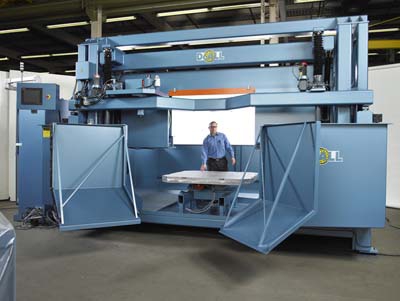
As the demand for solar energy and electronics increases worldwide, innovative equipment and processes are key to increase productivity at lower costs. Leading manufacturers of silicon wafers, the principal raw material used to produce solar panels and computer chips look to custom-manufacturers like DoALL Sawing Products to enhance the process. "The solar and semiconductor industry have rigorous standards," says DoALL Machine Tool Division Sales Manager Dave Snyder. "Their production facilities are looking for rugged, high precision, vibration free saws that can cut extremely hard material like silicon, quartz and other friable material." DoALL Sawing Products recently custom-engineered a series of diamond saws for a silicon ingot production facility. Ingots or boules, whether square or cylindrical, are extremely abrasive, brittle and expensive to produce. The large three axis HDS-1350 saw; D-900 series with rotary or stationary tables; and entry level or economical model 2012-D12 are currently serving production facilities across the globe. "There are very few diamond saw producers in the world because of the engineering demands," says Snyder. "The design involved on this custom project was significant, but among the end result was a custom software solution instructing the blade to enter and exit the ingot slowly, reducing chipping and waste on this expensive material. That's a big deal for the industry." The blade, also manufactured by DoALL, contains diamond crystals to make them extra tough on demanding, raw materials. The machine has features that optimize the blade performance and withstand the demands in a high-production facility. Diamond saws actually grind the material rather than cut it; the reason diamond saws are effective solutions to handle quartz, glass, carbide, Pyrex, carbon, graphite, gemstones and more.
Contact Details
Related Glossary Terms
- abrasive
abrasive
Substance used for grinding, honing, lapping, superfinishing and polishing. Examples include garnet, emery, corundum, silicon carbide, cubic boron nitride and diamond in various grit sizes.
- sawing
sawing
Machining operation in which a powered machine, usually equipped with a blade having milled or ground teeth, is used to part material (cutoff) or give it a new shape (contour bandsawing, band machining). Four basic types of sawing operations are: hacksawing (power or manual operation in which the blade moves back and forth through the work, cutting on one of the strokes); cold or circular sawing (a rotating, circular, toothed blade parts the material much as a workshop table saw or radial-arm saw cuts wood); bandsawing (a flexible, toothed blade rides on wheels under tension and is guided through the work); and abrasive sawing (abrasive points attached to a fiber or metal backing part stock, could be considered a grinding operation).
- sawing machine ( saw)
sawing machine ( saw)
Machine designed to use a serrated-tooth blade to cut metal or other material. Comes in a wide variety of styles but takes one of four basic forms: hacksaw (a simple, rugged machine that uses a reciprocating motion to part metal or other material); cold or circular saw (powers a circular blade that cuts structural materials); bandsaw (runs an endless band; the two basic types are cutoff and contour band machines, which cut intricate contours and shapes); and abrasive cutoff saw (similar in appearance to the cold saw, but uses an abrasive disc that rotates at high speeds rather than a blade with serrated teeth).






